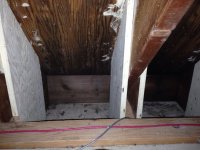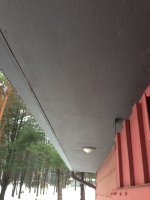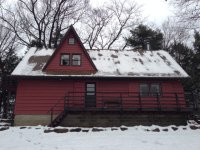tlj87
Gold Member
- Joined
- May 29, 2006
- Messages
- 434
- Location
- PA
- Tractor
- JD 4700, Kubota BX2370-1, Kubota RTV1140CPX, Kubota F3060, Club Car Precedent
At the beginning of the month, we moved into what was previously a three season, weekend only home. The building was constructed in the early-1970's and has non-vented soffit and no ridge vent. The walls and entire roof are insulated with foil backed fiberglass insulation (all space is finished including the attic). While in a kneewall today, I pulled back some of the insulation to look at the eaves and found the west end of the building (in photos, the end to the left of the dormer) were damp about 2-3 feet up from the soffit. I cut out the damp insulation and have fans drying the areas out. There is no obvious mold, punky wood or other issues although there is some slight discoloration which leads me to believe there has been some moisture here before. It is winter (almost) and any drastic measures are not feasible until spring, so I seek any advice to get us through the winter or maybe even completely address the issue. I've attached a few photos for reference. Thanks in advance!






Last edited: